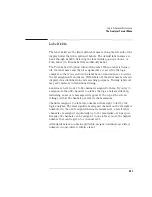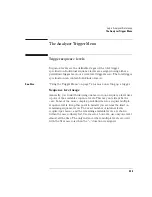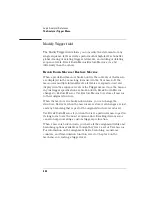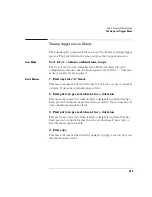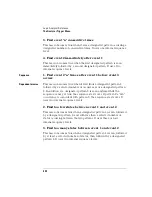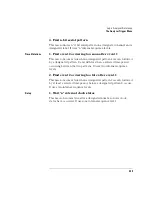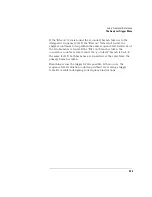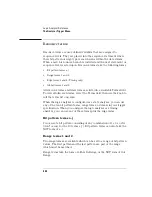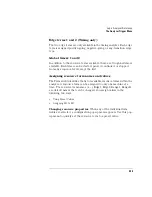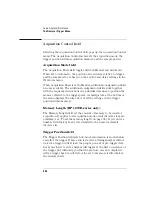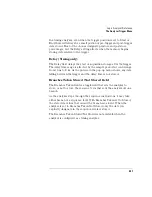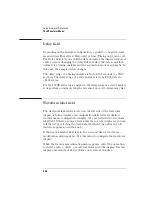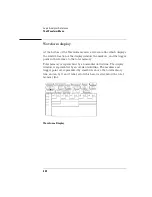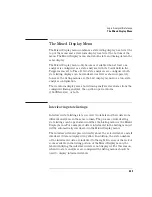
334
Logic Analyzer Reference
The Analyzer Trigger Menu
Resource terms
Resource terms are user-defined variables that are assigned to
sequence levels. They are placed into the sequence statement where
their bit pattern or edge type is searched for within the data stream.
When a match is found, a branch is initiated and the next statement or
sequence level is acted upon. Resource terms take the following forms:
•
Bit pattern terms a-j
•
Range terms 1 and 2
•
Edge terms 1 and 2 (Timing only)
•
Global timers 1 and 2
All resource terms and timer terms are listed in a scrollable Terms field.
To view all offscreen terms, select the Terms field, then use the knob to
roll the terms list onscreen.
When the logic analyzer is configured as a state analyzer, you can use
any of the ten bit pattern terms, range terms, or timers in your trigger
specification. When you configure the logic analyzer as a timing
analyzer, you can use any of these terms plus the edge terms.
Bit pattern terms a-j
You can set a bit pattern consisting of any combination of 1s, 0s, or Xs
(don't cares) for the 10 terms a ƒ j. Bit pattern terms can also take the
NOT form of a - j.
Range terms 1 and 2
Two range terms are available which can be set to a range of bit pattern
values. The first pattern and the last pattern are part of the range
which must be matched.
Range terms take the form of either In Range, or the NOT form of Out
Range.
Summary of Contents for 1670E Series
Page 6: ...6 In This Book...
Page 26: ...26 Contents...
Page 27: ...27 Section 1 Logic Analyzer...
Page 28: ...28...
Page 29: ...29 1 Logic Analyzer Overview...
Page 39: ...39 2 Connecting Peripherals...
Page 49: ...49 3 Using the Logic Analyzer...
Page 72: ...72 Using the Logic Analyzer The Inverse Assembler...
Page 73: ...73 4 Using the Trigger Menu...
Page 101: ...101 5 Using the Oscilloscope...
Page 151: ...151 6 Using the Pattern Generator...
Page 199: ...199 7 Triggering Examples...
Page 237: ...237 8 File Management...
Page 249: ...249 9 Logic Analyzer Reference...
Page 360: ...360 Logic Analyzer Reference The Compare Menu...
Page 361: ...361 10 System Performance Analysis SPA Software...
Page 397: ...397 11 Logic Analyzer Concepts...
Page 430: ...430 Logic Analyzer Concepts The Analyzer Hardware Oscilloscope board theory Oscilloscope board...
Page 439: ...439 12 Troubleshooting the Logic Analyzer...
Page 455: ...455 13 Specifications...
Page 471: ...471 14 Operator s Service...
Page 479: ...479 Operator s Service Troubleshooting Troubleshooting Flowchart 2...
Page 491: ...491 Section 2 LAN...
Page 492: ...492...
Page 493: ...493 15 Introducing the LAN Interface...
Page 497: ...497 16 Connecting and Configuring the LAN...
Page 506: ...506 Connecting and Configuring the LAN Connecting and Configuring the LAN...
Page 507: ...507 17 Accessing the Logic Analyzer File System Using the LAN...
Page 515: ...515 18 Using the LAN s X Window Interface...
Page 527: ...527 19 Retrieving and Restoring Data Using the LAN...
Page 539: ...539 20 Programming the Logic Analyzer Using the LAN...
Page 546: ...546 Programming the Logic Analyzer Using the LAN Programming the Logic Analyzer Using the LAN...
Page 547: ...547 21 LAN Concepts...
Page 555: ...555 22 Troubleshooting the LAN Connection...
Page 580: ...580 Troubleshooting the LAN Connection Getting Service Support...
Page 581: ...581 Section 3 Symbol Utility...
Page 582: ...582...
Page 583: ...583 23 Symbol Utility Introduction...
Page 588: ...588 Symbol Utility Introduction Symbol Utility Introduction...
Page 589: ...589 24 Getting Started with the Symbol Utility...
Page 597: ...597 25 Using the Symbol Utility...
Page 609: ...609 26 Symbol Utility Features and Functions...


